

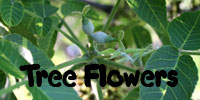

|
Welcome
to bobklips.com, the website of Bob Klips, a plant enthusiast living in
Columbus, Ohio.
Silver
Maple
Marion Cemetery, Marion, Ohio
March 17, 2009
The first
tree flower
of spring, silver maple (Acer saccharinum,
family Aceraceae) is an abundant species of moist or wet soil. It
is commonly planted along roads, and in parks and cemeteries
such
as the Marion Cemetery in Marion, Ohio. Silver maple flowers are
inconspicuous, but often get noticed as an early sign of spring, albeit
slightly misinterpreted as people cheerfully report seeing maple
"buds." Actually, silver maple buds are evident throughout
the
winter, and the striking change we see in early-mid March is
the actual emergence of flowers from the buds
Over the winter, silver maple flowers were contained within globose
clusters of lateral
buds. Here's what their twigs looked like during midwinter, 2008.
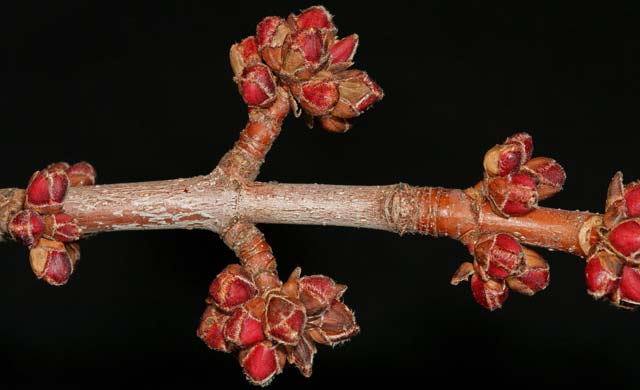
Silver maple winter twig showing clusters of flower buds.
Like many tree flowers, silver maple sexual expression isn't very
clear-cut. At the Marion Cemetery, some individual trees seem to have
only flowers all of one sex, either male ot female but not both. Yet
some had both male and female flowers, located on
different parts of
the tree. And some seemingly pistillate (female) flowers appeared to
have stamens, but they were tucked deep in the blossom,
unexpanded.
For interpretive guidance, it helps to consult a detailed
and authoratative botanical manual.
Here's what H.A. Gleason said about maples in the best book ever
written, New Britton and Brown Illustrated
Flora of the Northeastern United States and Adjacent Canada:
Description
of maples
from a regional flora, H.A. Gleason's New Britton and
Brown (1952).
That helps. We're looking for unisexual
flowers, but they might only be
"functionally" unisexual, i.e. possessing vestigial organs of the
unexpressed sex. Further, Gleason tells us that
silver maple flowers lack petals, and, moreover, that each flower
cluster is either
wholly staminate or wholly pistillate. Although the manual doesn't say
so, it
seems like some trees are wholly staminate, some are wholly pistillate,
and
still others are a mixture (monoecious). The following pictures are
from separate
trees, both of which appear to be unisexual.
Here are male flowers. Note the slender filaments
sticking pollen-containing anthers well out into the breeze.
(The
species is
wind-pollinated.)
Silver maple male flowers. March 17, 2009.
Marion,
Ohio.
...And here
are the
female ones. Note the two elongate style-branches, well positioned to
receive wind-borne pollen.
Silver maple male flowers. March 17, 2009.
Marion,
Ohio.
While
scouting the
vicinity west of Marion
near the Little Sandusky River for suitably photogenic silver maples,
it was a thrill to see a bald eagle flying
overhead, attracting
also the attention of a red-tailed hawk.
Immature bald eagle being harassed by
red-tail. West
edge of Marion, Ohio. March 17, 2009.
Skunk cabbage.
Delaware County, Ohio.
March 8-13, 2009.
The
first wildflower of spring, skunk cabbage (Symplocarpus
foetidus,
family Araceae) is a rugged and long-lived perennial that can
be
extremely abundant in open bottomlands such as this area along a
tributary to Alum Creek in eastern Delaware County, Ohio.
Skunk
cabbage growing
in open area along woodland creek. March 8, 2009, Delaware County,
Ohio.
Skunk
cabbage is famous
for its ability to
generate heat and plants can sometimes be seen iconically poking their
noses
through a late-winter blanket of snow, as seen last year at this same
location.
Skunk
cabbage poking
through snow, March 1, 2008, Delaware County, Ohio.
Skunk
cabbage
leaves appear soon after the flowers. Here's what they looked
like in
mid-April
a few years ago.
Skunk
cabbage. April
15, 2006. Delaware County, Ohio.
The arum
family is
distinguished by a unique type of inflorescence consisting of a dense
flower spike, the spadix, situated beneath
a large overarching bract, the spathe.
A familiar example is the woodland wildflower
Jack-in-the-pulpit (Arisaemia
triphyllum) wherein the spadix
is the preacher "Jack" and the spathe is his pulpit.
Another
arum species, green dragon (A. dracontium), looks
like a
dragon, I guess. Here's what these two woodland wildflowers looked when
they were
blooming in mid-May within the past few years.
Representative
members of the arum family (Araceae).
Left: Jack-in-the-pulpit. Hocking County, Ohio, May 9, 2005.
Right: green dragon. Delaware County, Ohio, May
19, 2008.
The skunk cabbages are in full bloom this week. Here's a typical pair
of inflorescences, wherein only the spathes are visible, as each spadix
is nearly completely concealed within its spathe. To more fully
understand these inriguing (and very abundant) flowers, I
sectioned a spathe to expose the spadix within.
MOUSEOVER
the IMAGE
to see the spadix. 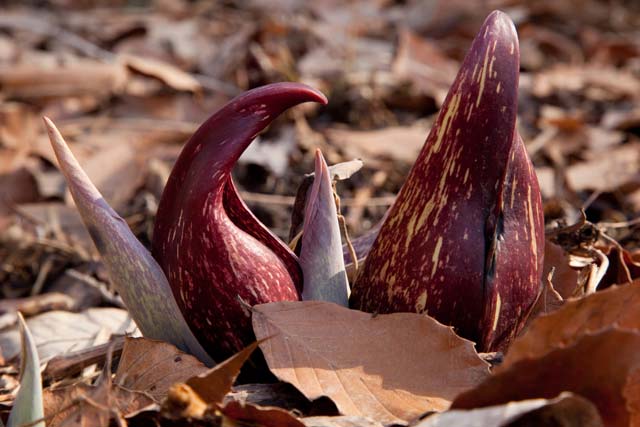
Skunk cabbage
inflorescences. March 8, 2009. Delaware County, Ohio.
The
head-like spadix
consists of many
small flowers tightly packed together. Gently
prying apart the margins of the spathes of several plants
and peeking within, it is evident that all of a spike's flowers develop
simultaneously. Moreover, there are three evident stages of
development, presented below.
(1) A stage when the only visible sexual parts are the female
stigmas (i.e., no stamens).
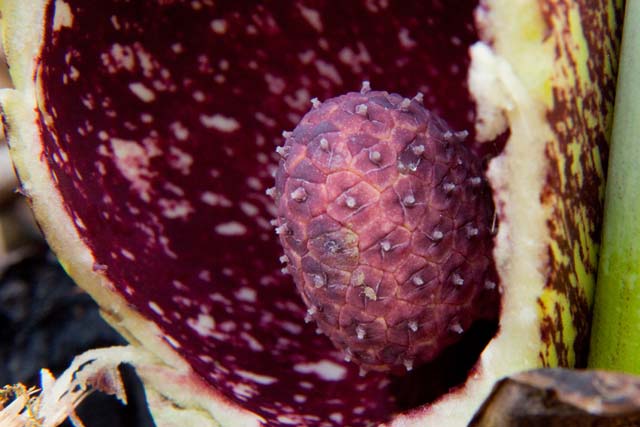
Skunk cabbage inflorescence, pistillate (female) stage. March 9, 2009.
Delware County, OH.
Skunk
cabbage
inflorescence staminate (male) phase. March 13, 2009, Delaware County,
Ohio.
(3) A stage with obviously "spent" (dehisced)
anthers and copious amounts of dry dusty pollen at the
base of the chamber.
Skunk
cabbage
late-stage inflorescence. March 11, 2009. Delaware County, Ohio.
Swayed by the striking differences between these presentations
I jumped to an initial cursory but wholly incorrect supposition that
the
species is dioecious (separate male and individuals). Interpretation
of the structure
of small and somewhat modified flowers can be challenging, and is best
done by methodically checking observations of flowers
made through a lens against
their description in a detailed and authorative botanical manual.
Here's what H.A. Gleason said about skunk cabbage in the best book ever
written, New Britton and Brown Illustrated
Flora of the Northeastern United States and Adjacent Canada:
Description
of skunk
cabbage from a regional flora, H.A. Gleason's New Britton and
Brown (1952).
Surprise! These plants are not dioecious or even monoecious; the
flowers are "perfect"
(hermaphroditic, bearing both stamens and pistils). It
is evident therefore that skunk cabbage exhibits "protogyny,"
a
sequential maturation of the differently sexed flower parts, wherein
the female pistil ripens first.
The following is a studio portrait of a portion of a
spadix during the early, female, stage of flowering.
Using a sharp razor blade, a thin tangential slice was made through
through the spadix, resulting in an upper
cross-section of several flowers, exposing and
making evident some of the floral features spelled
out
in the
Gleason synopsis. Progressing inwards these are: the 4
perianth segments, the anther portions of the 4 stamens, and the
central angular style portion of the pistil. In the unsectioned face
view, the upper portions of the perianth segments and the stigma
portion of the pistil are visible, but the stamens are not.
MOUSEOVER
the IMAGE
to see the flower parts labelled. 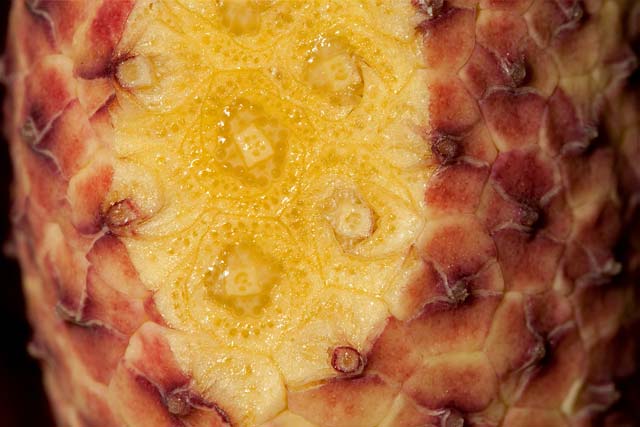
Skunk cabbage spike in early (pistillate) stage showing 4 perianth
segments,
4 anthers (sectional view only), the stout central style
(sectional view only) and stigma (intact face view).
When it's
time to
disperse pollen, the filaments elongate and push the anthers
out from their comfortable nest between the perianth segments
and the pistil. Afterwards, the anthers are evident, clearly exert
above the perianth. A tangential sectional similar to the one
above reveals filaments
positioned where previously there were anthers.
MOUSEOVER
the IMAGE
to see the flower parts labelled. 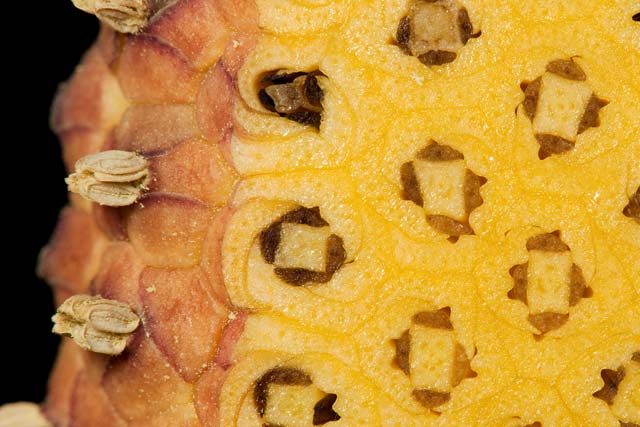
Skunk cabbage spike in late (staminate) stage showing 4 perianth
segments (shaded),
anthers (showing in intact face view only), filaments (in section view
only), and the stout central style.
What loggers
call a
"radial section,"
i.e., a longitudinal cut that passes through the center of a
cylinder, of the spadix reveals longisection side views of individual
flowers.
This view shows what Gleason was referring to with "Ovary buried in the
tissue of the spadix, 1-celled, 1-ovuled; style stout, elongate." It
would be nice to return in a month or so and see the "Seeds embedded in
the large spongy spadix, covered by the persistent perianth and
style."
Drippy
Tree!
Roadside sugar maple gives car a
sweet shower.
March 8, 2009
This time of
the year,
maple sap is
flowing freely, and the local syrup producers are hard at work, as this
excellent article in the Columbus (Ohio) Dispatch attests.
The
Clintonville
neighborhood of Columbus
is enhanced by the presence of a great variety of roadside trees. Some
of them are forest giants that annoy the electric, phone and cable
companies and also stand scarily sword-of-Damacles-like over
some
of the houses. One such tree is a majestic sugar maple that seems to be
declining a bit and so has some broken branches, probably a result
of the
September 2008 windstorm that spun off of Hurricane Ike.
Google
Earth aerial
view of roadside sugar maple (2004).
Parked beneath this maple is a red 1994 Honda Civic del Sol that looks
all drippy, as if it was rained on, but it hasn't rained lately! A
taste-test revealed the drops to be faintly sweet. The
overarching
sugar maple,
emulating its syrup-serving country brethren, has its sap flowing too,
and it leaked, sugar-coating the car!
Sap-soaked
top of red
car parked beneath roadside sugar maple. March 8, 2009.

Earlier observations ("next")
|

